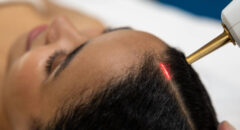
This week, the world says goodbye to the series, "How To Get Away With Murder." It's cast, storylines and fans will be missed. Viola Davis, the breakout star who has been vocal about her thoughts on being called “less classically beautiful,” opened up about her own struggles with beauty and how she balanced her health with what society thought as beautiful.
One of our favorite episodes was when Davis' character, Annalise, takes off her wig and reveals her true, shorter, natural-haired self at the end of a trying day (see video below). It's something many of us can relate to.
In a magazine interview, Davis shared her that in real life, she lost half her hair at age 28 to Alopecia areata and how she would wear a wig everywhere to feel beautiful:
MUST READ: The Truth About Postpartem Hair Loss
“I woke up one day and it looked like I had a Mohawk. Big splash of bald on the top of my head,” she says. “I was like, What is this? Until I found out it was stress related. That’s how I internalized it. I don’t do that anymore. My favorite saying in the world is, ‘The privilege of a lifetime is being who you are.’ I am telling you, I have spent so much of my life not feeling comfortable in my skin. I am just so not there anymore.”
Alopecia areata is a common disease that results in the loss of hair on the scalp and elsewhere on the body. There are three types of alopecia areata; alopecia areata, alopecia areata totalis and alopecia areata universalis. In all forms of alopecia areata, the hair follicles remain alive and are ready to resume normal hair production whenever they receive the appropriate signal. In all cases, hair regrowth may occur even without treatment and even after many years.
Alopecia Areata Patchy
Alopecia areata, the most common variation of the autoimmune disease, presents itself as round, smooth patches of various sizes.
Alopecia Areata Totalis
Alopecia areata totalis presents itself as total loss of hair on the scalp
Alopecia Areata Universalis
Alopecia areata universalis is the rarest form of alopecia areata and presents itself as the loss of hair over the entire scalp and body.
READ: What Relaxers Really Do To Your Hair
After Alopecia, she wore a wig everywhere.
“I wore a wig in the Jacuzzi. I had a wig I wore around the house. I had a wig that I wore to events. I had a wig that I wore when I worked out. I never showed my natural hair. It was a crutch, not an enhancement … I was so desperate for people to think that I was beautiful. I had to be liberated from that [feeling] to a certain extent.” So at the 2012 Oscars, she exposed her “natural hair.” She still has her wigs; she wears them on Murder, she wears them to photo shoots, she wears them when she doesn’t have time to pick out her hair and get rid of her grays, but she no longer wears them in her everyday life. What matters, she says, is that “it’s an option … when it used to never be an option. I had something to hide.”









